 Here
as elsewhere, according to conformist
history, the Nazis did a thorough job of
erasing all trace that they had ever been
here. Here
as elsewhere, according to conformist
history, the Nazis did a thorough job of
erasing all trace that they had ever been
here.
|
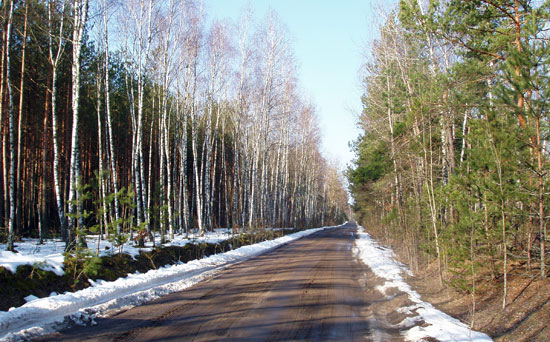
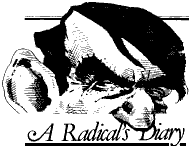 March
7, 2007 (Wednesday) March
7, 2007 (Wednesday)
Wlodawa
- Sobibór - Lublin - Warsaw
(Poland)
AFTER breakfast I set out with Alan to visit the
site at Sobibór, seven kilometers away. He
is nervousness personified. He is the only person I
know who has felt-penned a web of cracks onto both
wing-mirrors of his car to discourage would-be
wing-mirror-thieves. That's Poland for you. The
land of car thieves: "Welcome to Warsaw," goes the
local joke. "Your car is already here
somewhere." His car boot is filled with leaky cans of
diesel, which is good thinking. But he is surprised
when I fold the black woollen overcoat I have
borrowed onto the back seat, instead of consigning
it to the car's boot, and he agonizes perpetually
that somebody may steal it one night. We drive out to Sobibór in weak winter
sunshine through idyllic sandy pastures and then
birch forests. The site is windswept and remote,
another logging camp. Not an unattractive place to
die, I remark to Alan -- because it seems clear
that a lot of people have at one time died
here. 
 Next
to the little Sobibór railroad station,
which has five or six tracks and sidings, there are
two or three houses for logging workers, built in
the post-war communist shoebox style. Three or four
more houses face the little station, but they are
all post-war. The villa occupied in 1942 by
Franz Stangl and the other Sobibór
commandant Franz Reichleitner, a green
structure, is still standing here, its light green
roof just visible above the railroad waggons. Next
to the little Sobibór railroad station,
which has five or six tracks and sidings, there are
two or three houses for logging workers, built in
the post-war communist shoebox style. Three or four
more houses face the little station, but they are
all post-war. The villa occupied in 1942 by
Franz Stangl and the other Sobibór
commandant Franz Reichleitner, a green
structure, is still standing here, its light green
roof just visible above the railroad waggons.
Not far away, a modern museum building dominates
the little parking lot, but it is open only from
May to October. A few feet from the museum are
loose concrete covers with iron handles, and there
are possibly wells or cesspits beneath. Like Treblinka, the site is set deep in the
forest. Most of the trees are pre-World War II and
deeper into the forest we find at least two
man-made pits or depressions round the back of the
site, each about fifty yards long, three yards
wide, and two or three feet deep (see
below), with much younger trees growing on
their floor, only a few years old and flanked by
much older coniferous trees. 
Here as elsewhere, according to conformist
history, the Nazis did a thorough job of erasing
all trace that they had ever been here after the
camp closed, which was after a prisoner-uprising on
October 14, 1943. One plaque rather oddly proclaims
that "250,000 Jews and 1,000 Poles" (sic) were
killed here. I suspect that the American Jewish
Committee had a hand in the wording; they never did
like each other. The now familiar tasteless monuments mark what
they estimated to have been the heart of the
Sobibór site: one is a thirty-foot tall
square tower with sides of crazy-paving slabs,
innocent of any entrances or inscription, another
is a statue built of three or four terra-cotta
stone blocks piled on top of each other, and hewn
roughly into the shape of a woman and possibly a
child; a hundred yards or more away, between them
and the pits we found, there is the main monument,
a round shallow dome-shaped mound, evidently
representing a heap of ashes, about a hundred
meters in diameter. The area is untidy with a litter of candles and
receptacles, a beer bottle etc, left behind by the
living visitors who have come to commemorate the
dead. I am reminded of what Generaloberst Alfred
Jodl wrote in his last letter from Nuremberg,
"The dead march way out in front, followed by the
living" -- voraus die Toten, dahinter die
Lebenden.  THEY have now cleared a broad avenue through the
forest, quite recently, and lined it with young
firs -- they look like Christmas trees -- and small
football-sized stones, each with a memorial plaque
pinned to it naming a family's or individual's
departure date from Holland or Germany and the date
of their arrival here (presumably from transport
records), the latest date I saw being July 1943,
the earliest around March or June 1942; for
example, there is one plate for a Louis de
Jong and his family from Arnhem, Holland. They
are mostly Dutch or German, very few Poles. No
plates mark the sites of the alleged gas chambers.
Alan points out one site, about twenty yards
square, but I remark that there is a tree stump in
its center that is clearly older than sixty years
(which does not mean that the other clearings would
not have been large enough).
THEY have now cleared a broad avenue through the
forest, quite recently, and lined it with young
firs -- they look like Christmas trees -- and small
football-sized stones, each with a memorial plaque
pinned to it naming a family's or individual's
departure date from Holland or Germany and the date
of their arrival here (presumably from transport
records), the latest date I saw being July 1943,
the earliest around March or June 1942; for
example, there is one plate for a Louis de
Jong and his family from Arnhem, Holland. They
are mostly Dutch or German, very few Poles. No
plates mark the sites of the alleged gas chambers.
Alan points out one site, about twenty yards
square, but I remark that there is a tree stump in
its center that is clearly older than sixty years
(which does not mean that the other clearings would
not have been large enough).
Alan says he picked up bone fragments on earlier
visits, but I doubt he has the forensic knowledge
to recognize such things. The whole site reveals no
forensic evidence of homicidal activities, to
supplement the relatively strong documentary
evidence which exists. Barbed wire has been found
and archeological digs and probes have provided
evidence of bone fragments indicating possible
gravesites. They found 1,200 small-arms cartridge
cases where the gas chambers were believed to be
(possibly used to finish off survivors of gassings,
it is surmised). They also found many such
small-arms cartridge cases near the Lazarett
(camp hospital). These are on display in the museum, says Alan,
along with photos of the camp's dramatis
personae. The principal sources of information
on its homicidal activities are Franz
Stangl, the commandant here (and later at
Treblinka), and survivors like Stanislaw
Szmajzner and Thomas Blatt, and
now
of course the Höfle document. 
 WE drive at a leisurely pace from Sobibór
back to Lublin and by one p.m. we have arrived at
its homicidal suburb, Majdanek -- the site of the
vast Nazi prison camp straddles a gentle rise, and
is clearly visible from the highway and city
buildings. Alan explains that only the Nazi
trustworthy and notables would have lived in the
wartime buildings that are visible along the camp's
fringe. (But would they not have employed local
Poles as servants, cooks, valets and the like?)
WE drive at a leisurely pace from Sobibór
back to Lublin and by one p.m. we have arrived at
its homicidal suburb, Majdanek -- the site of the
vast Nazi prison camp straddles a gentle rise, and
is clearly visible from the highway and city
buildings. Alan explains that only the Nazi
trustworthy and notables would have lived in the
wartime buildings that are visible along the camp's
fringe. (But would they not have employed local
Poles as servants, cooks, valets and the like?)
The memorial area at Majdanek is as big as
Croydon airfield, on a slope ascending to a
monument (not that illustrated above) which
looks like a giant flying saucer that has landed on
a hilltop, marking where once the alleged gas
chamber stood. Those alleged installations have now
been relocated in a wooden building several hundred
yards away, in the camp exhibition area, and are
housed in a building identified on a fake wartime
signboard as "Bad- und Disinfektion".  Before
going in there, we visit the crematorium and
morgue: what a way to spend an afternoon. It is
empty of people, and we prowl around. Before
going in there, we visit the crematorium and
morgue: what a way to spend an afternoon. It is
empty of people, and we prowl around.
An un-tiled cement dissecting-table stands in
the middle of one room; I look for a waste-water
outlet and find it between the table legs, which
seems fair enough. The inscription on a plaque says
that the table was used for extracting teeth and
searching bodies for hidden valuables; which is
less probable. The signs seem rather
over-enthusiastic in their description of Nazi
Schrecklichkeit, which is not helpful. The four or five crematorium ovens, in a room
that is deliberately dimly lit, do make a sobering
display. I wonder how many victims this
installation could have handled each day -- the
rate would not be very high, I guess. It did not
seem set up for mass operations. 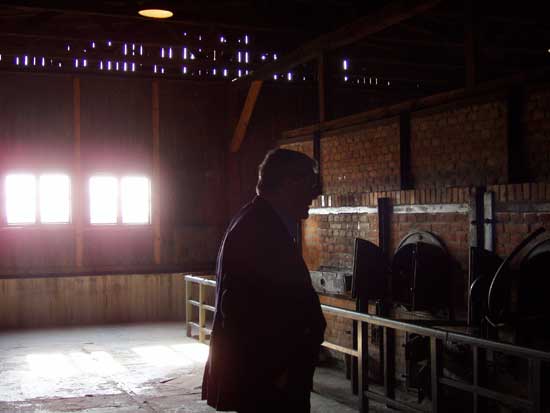
It is all rather odd. The wooden part of the
next building, the ominous "Bad- und Disinfektion"
building, was fire-damaged a few years ago, when
worshippers left burning candles. The rebuilding
with modern creosoted woodwork has not added to the
aura of authenticity.  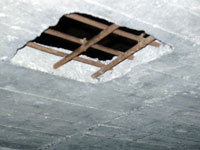  THERE are some startling discoveries for me,
however. The cement or concrete ceilings and walls
(though not the floors), of these deliberately
ill-lit rooms, identified to tourists as homicidal
gas chambers, are remarkable for large dark
patches, which are clearly visible to me, the
familiar hue of Prussian Blue, stained into -- and
in more than one case right through -- the walls;
there are half a dozen such rooms, large and
small.
THERE are some startling discoveries for me,
however. The cement or concrete ceilings and walls
(though not the floors), of these deliberately
ill-lit rooms, identified to tourists as homicidal
gas chambers, are remarkable for large dark
patches, which are clearly visible to me, the
familiar hue of Prussian Blue, stained into -- and
in more than one case right through -- the walls;
there are half a dozen such rooms, large and
small.
 These
dramatic stains themselves are not remarked upon
anywhere on the tourist information inscriptions. I
would have broken away a small flake for laboratory
testing had I been so inclined, but I was not. No
doubt others now will. Besides, Alan was piously
frowning. These
dramatic stains themselves are not remarked upon
anywhere on the tourist information inscriptions. I
would have broken away a small flake for laboratory
testing had I been so inclined, but I was not. No
doubt others now will. Besides, Alan was piously
frowning.
There were puzzling features. One hole in the
ceiling -- the suggestion is that the SS tipped
cyanide crystals in through this hole -- is clearly
of post-war etiology, as the reinforcing bars
crisscross it; the concrete is only three inches
thick, which seems thin for a load -bearing
floor. Moreover at least one of these blue-stained
rooms has a large glass window about seven feet
above floor level (see photo), which could
easily have been smashed ("I don't know about you
guys, but I'm going to stand over here by the
window"). None of the text descriptions draws any
attention to the blue stains. Alan has not noticed
them before, but has photos from earlier years
which he will dig out for me. Short of independent
chemical tests being conducted on the stains --
shades of Fred
Leuchter! -- I don't know what to make of
them. There is also a small room in this building
containing two slim steel gas cylinders, no doubt
provded for photographers to snap at:  the
pipes leading through the wall appear to be newly
cemented in. the
pipes leading through the wall appear to be newly
cemented in. Over-eager cosmetic surgeons have been at work
on the site, as usual, and have forever damaged its
forensic value. For example, one space identified
as a gas chamber has no stains at all. Perhaps its
walls have been newly rendered? Nothing would
surprise me. Unfortunately the official Majdanek site museum
is closed, as was the Sobibór one this
morning, as the tourist season proper has not yet
begun. There are several watch towers, including
evidently genuine ones, perhaps renovated; which
compare well with the fakes installed at Auschwitz.
I remark to Alan that Poland could at least have
put all these sites which we have visited under one
body to coordinate such matters, like the National
Parks Service, as the clumsy fakery does rather
spoil the effect. 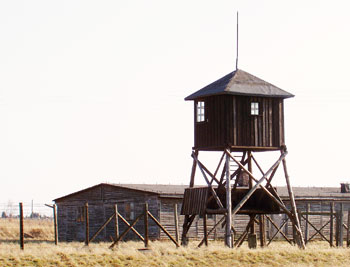
WE DRIVE off toward Warsaw, and look for a
restaurant with Internet to retrieve emails. Our
six-day tour is complete. At three p.m. we finally
find a lunch place that has Internet. There are
seventy messages, including one from Benté
(I phoned her from Majdanek briefly to say we're
all right: she says that Jessica's school has
agreed to reduce her fees by forty percent for this
term and the next, in view of the shortfall created
by my
imprisonment in Austria, which is very nice --
the reduction, not the imprisonment.) So my life gradually gets back to normal: a
correspondent tells me that Deborah
Lipstadt has wailed on her blog: "Throughout his prepared remarks,
Irving was pointedly careful to avoid even
mentioning the word Jew. He was quick to respond
to questions with his belief that he is actually
a liberal. . . As some sort of proof,
he offered up his belief that Franklin Roosevelt
was America's greatest president." Evidently a hard-to-please woman. Documentary
producer Rex
Bloomstein wants to start filming soon. He
could have come with us; now he's missed the
chance. A lady has sent me two Reinhard
Heydrich documents for an opinion: I respond,
"My professional opinion is that both documents are
genuine, based on what you have shown me. In
particular the signature compares well with his
genuine signatures, and the documents are addressed
to a little known official (fakes are usually
addressed to well known, notorious figures)." We arrive back in Warsaw in the late evening. I
find a message waiting, from my daughter Beatrice
in Brisbane, Australia: She is scheduled to give
birth "at 8.30 a.m. Oz time today." I look at a
clock -- that is at this very moment in Warsaw,
Poland. At 8:48 I send this message to her husband:
"I am in Warsaw, Poland. Please wish Beatrice all
the best and [say] I have just opened the
mail and am thinking about her now." Shortly, he
comes back to me: "It's a boy." So life goes on. I am banned
by the Australian prime minister from visiting his
country, and years may pass before I see my new
grandchild. "We'll change the law if necessary to
keep Mr Irving, out," that's what John
Howard has said in Parliament. He knows which
side his party's bread is buttered on March
8, 2007 (Thursday)
Warsaw
(Poland) - Budapest (Hungary) At 11:10 a.m. I send congratulations to Beatrice
in Brisbane: "Well done. . . What will his name be?
I am telling everybody here of course, and I am
very pleased. Well done to you both, and long may
you and R. enjoy this new happiness. You've got a
fine husband there." At one-ten p.m. I leave Warsaw by plane for
Budapest. It has been a very successful six-day
tour of the Nazi sites, with some disturbing and
interesting conclusions. So much could have gone
wrong. We covered nearly two thousand kilometers
between the sites. Alan has been a real brick, and I am sure I got
on his nerves. At Budapest airport I notice
television cameras clustering on the far side of
the arrivals lounge. MTV, Hungarian National TV,
are filming my arrival. My host is waiting for me. The TV people dog us
out into the parking lot. They ask me why I have
come to Hungary, and I reply -- quite truthfully --
for a visit to the dentist. And to get some
peace. "Have you an official programme?" they
ask. [Previous
Radical's Diary]  Donate
| regularly Donate
| regularly
  Our
dossier on the Holocaust
Our
dossier on the Holocaust Sobibor
website | graves
found at | The
Scotsman
Sobibor
website | graves
found at | The
Scotsman Slow-news day: Hungarian
controlled TV reacts to Mr. Irving's return to
Budapest
Slow-news day: Hungarian
controlled TV reacts to Mr. Irving's return to
Budapest  [Hungarian TV
news]
[Hungarian TV
news] A
well-produced revisionist film on problems with
the Holocaust controversy
A
well-produced revisionist film on problems with
the Holocaust controversy
|